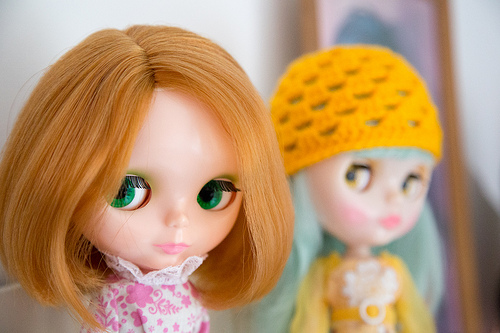
I am always fascinated by the intersection of fandom and craft, and Blythe dolls sit perfectly on that line. And they draw my attention even more, because I have never been even the slightest bit interested in playing with dolls. Not now, and not as a child. This means that I find it fascinating to see people spending so much time on their Blythe dolls, and the meticulous care they use to construct their scenes.
Blythe dolls are about 11 inches tall, and have oversized heads with big, soulful eyes. (The eyes change color by pulling a string at the back of her head.) They were originally made by Kenner in 1972, but were dropped from the market after a year due to lack of interest. In the late 90s, Blythe dolls were produced again in Japan.
The epicenter for the Blythe doll fandom seems to be the work of a photographer, Gina Garan, who took her Blythe doll everywhere, snapping hundreds of photos of Blythe in New York City. These beautiful photos were published in a book called This is Blythe in 2000.
Most Blythe doll owners seem to favor one or two dolls in their collections. They are given names, and customized outfits, and their hobbyists set them in intricate tableaux, both to-scale and not. I most often run across pictures of Blythe dolls on Flickr, where many groups of Blythe doll fans exist.
Unlike Barbie, who has been shaped by the male gaze, Blythe is not sexualized. Her most obvious feature are her eyes and hair. Her body is streamlined and rectangular, without breasts or hips. Also unlike Barbie and other dolls, Blythe has an interesting depth to her expression.
Blythe fans create elaborate worlds for their dolls, including vast wardrobes of perfectly to-scale clothing. The craftsmanship alone is astounding, and the photography is top notch.
Image courtesy Flickr/Jazza2

0 comments